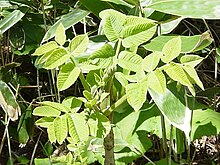| Toxicodendron vernicifluum | |
|---|---|

| |
| Scientific classification | |
| Kingdom: | Plantae |
| Clade: | Tracheophytes |
| Clade: | Angiosperms |
| Clade: | Eudicots |
| Clade: | Rosids |
| Order: | Sapindales |
| Family: | Anacardiaceae |
| Genus: | Toxicodendron |
| Species: | T. vernicifluum
|
| Binomial name | |
| Toxicodendron vernicifluum (Stokes) F. A. Barkley
| |



Toxicodendron vernicifluum (formerly Rhus verniciflua[1]), also known by the common name Chinese lacquer tree,[1][2][3] is an Asian tree species of genus Toxicodendron native to China and the Indian subcontinent, and cultivated in regions of China, Japan and Korea.[4] Other common names include Japanese lacquer tree,[5] Japanese sumac,[4] and varnish tree.[5] The trees are cultivated and tapped for their toxic sap, which is used as a highly durable lacquer to make Chinese, Japanese, and Korean lacquerware.
The trees grow up to 20 metres tall with large leaves, each containing from 7 to 19 leaflets (most often 11–13). The sap contains the allergenic compound urushiol, which gets its name from this species' Japanese name urushi (urushi (漆)); "urushi" is also used in English as a collective term for all kinds of Asian lacquerware made from the sap of this and related Asian tree species, as opposed to European "lacquer" or Japanning made from other materials. Urushiol is also the oil found in poison ivy and poison oak that causes a rash.
- ^ a b "PLANTS Profile for Toxicodendron vernicifluum (Chinese lacquer)". Natural Resources Conservation Service. United States Department of Agriculture. Retrieved 8 August 2011.
- ^ Yun-Yang, W.; Yu-Min, D.; Fang-Xing, Y.; Ying, X.; Rong-Zhi, C.; Kennedy, J. F. (2006). "Purification and characterization of hydrosoluble components from the sap of Chinese lacquer tree Rhus vernicifera". International Journal of Biological Macromolecules. 38 (3–5): 232–40. doi:10.1016/j.ijbiomac.2006.02.019. PMID 16580725. S2CID 22810554. Archived from the original on 24 January 2021. Retrieved 10 December 2019.
- ^ Mabberley, D. J. (2002). The plant-book: A portable dictionary of the vascular plants (2nd ed.). Cambridge, U.K.: Cambridge University Press. p. 286. ISBN 978-0-521-41421-0.
- ^ a b "Toxicodendron vernicifluum". Germplasm Resources Information Network. Agricultural Research Service, United States Department of Agriculture. Retrieved 10 December 2013.
- ^ a b "Common Names for Chinese Lacquer (Toxicodendron vernicifluum)". Encyclopedia of Life. Retrieved 10 December 2013.